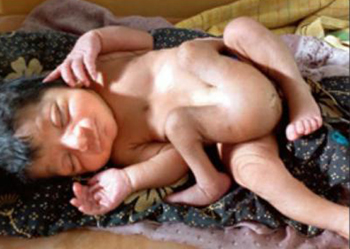Ballari, Jan 23: A woman delivered a baby with four legs and two male sex organs at the Dhadeasugure Primary Health Centre (PHC) in Raichur in the early hours of Saturday.
 Born to Lalitamma, 23, and Chennabasava, 26, residents of Puladinni village in Dadeasugure Hobali of Sindhanoore taluk in Raichur, the infant was taken to Vijayanagara Institute of Medical Sciences (VIMS), Ballari ,on Saturday evening. The baby has been placed in neonatal care at VIMS.
Born to Lalitamma, 23, and Chennabasava, 26, residents of Puladinni village in Dadeasugure Hobali of Sindhanoore taluk in Raichur, the infant was taken to Vijayanagara Institute of Medical Sciences (VIMS), Ballari ,on Saturday evening. The baby has been placed in neonatal care at VIMS.
Dr Virupaksha T said the infant was born at 4.23am on Saturday. Having been on duty at the time of the child's birth, he made all the necessary arrangements to facilitate the baby's transfer to VIMS. "It was a normal delivery," Dr Virupaksha said.
Initially, Lalitamma was reluctant to tak e the infant to VIMS for higher treatment. "It is God's gift to us," she told the doctors.
However, after her family members and the hospital staff counselled her, she agreed to take the baby to Ballari.
"I referred the family to VIMS. I spoke to the surgeons there on Su nday, and they told me that the baby was being kept under observation. I hope the infant becomes normal," Dr Virupaksha added.
Dr Divakar Gaddi, who is handling the baby's case at VIMS, said, "A team of surgeons is looking into the baby's condition. It is a very challenging case for us." Lalitamma said she was willing to raise her newborn child just the way he was. "My first son, born three years ago, is healthy. We are poor and cannot afford expensive treatment," she added.
Reiterating that her second child was a gift from God, Lalitamma told TOI, "The doctors and members of my family advised me to take the baby to VIMS for advanced treatment. Now, I am hoping he becomes normal."





Comments
Add new comment